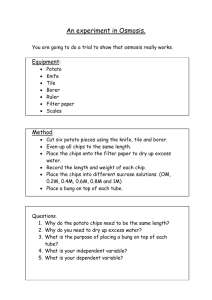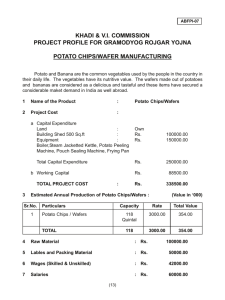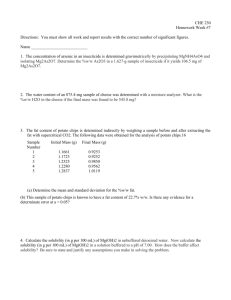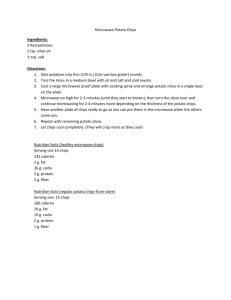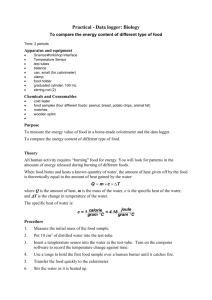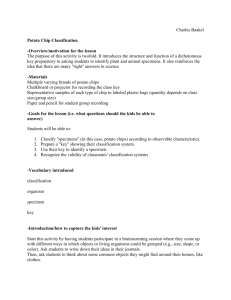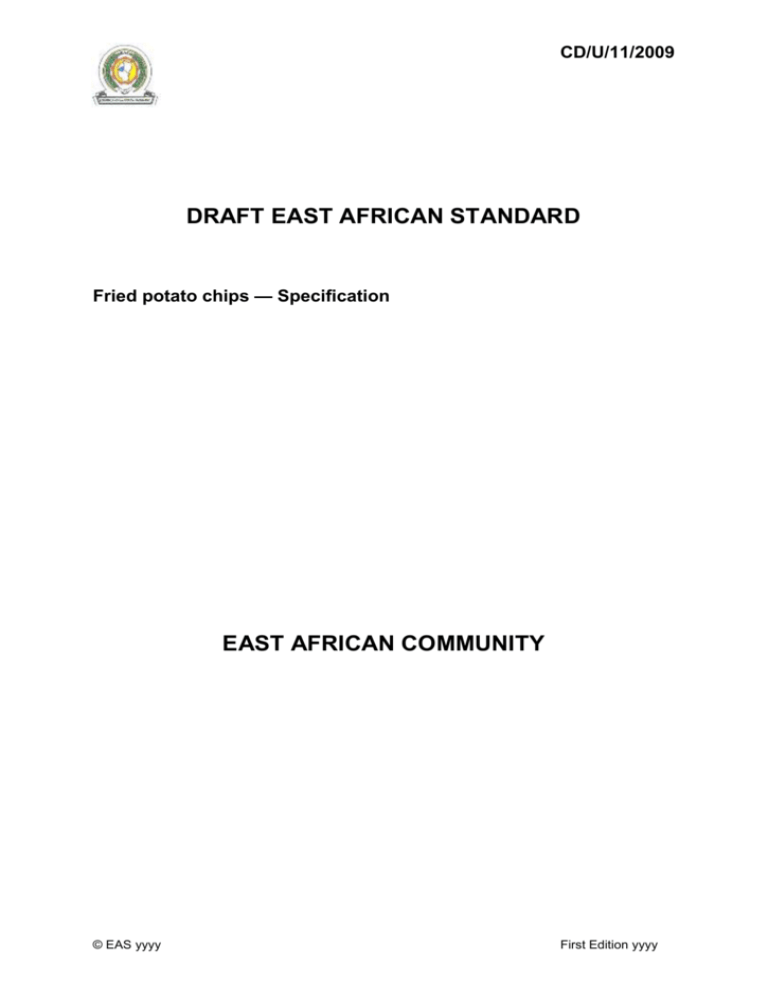
CD/U/11/2009
DRAFT EAST AFRICAN STANDARD
Fried potato chips — Specification
EAST AFRICAN COMMUNITY
© EAS yyyy
First Edition yyyy
CD/U/11/2009
Foreword
Development of the East African Standards has been necessitated by the need for harmonizing requirements
governing quality of products and services in East Africa. It is envisaged that through harmonized
standardization, trade barriers which are encountered when goods and services are exchanged within the
Community will be removed.
In order to achieve this objective, the Partner States in the Community through their National Bureaux of
Standards, have established an East African Standards Committee.
The Committee is composed of representatives of the National Standards Bodies in Partner States, together
with the representatives from the private sectors and consumer organizations. Draft East African Standards
are circulated to stakeholders through the National Standards Bodies in the Partner States. The comments
received are discussed and incorporated before finalization of standards, in accordance with the procedures
of the Community.
East African Standards are subject to review, to keep pace with technological advances. Users of the East
African Standards are therefore expected to ensure that they always have the latest versions of the standards
they are implementing.
This standard was developed with support from the Association for Strengthening Agricultural Research in
Eastern and Central Africa – Eastern and Central Africa Programme for Agricultural Policy Analysis
(ASARECA-ECAPAPA) project. The project support was invaluable in the mobilisation of stakeholders and
provision of resources for the process of formulation of the standards. This support and the support from all
other stakeholders are hereby acknowledged
© East African Community yyyy — All rights reserved*
East African Community
P O Box1096
Arusha
Tanzania
Tel: 255 27 2504253/8
Fax: 255-27-2504481/2504255
E-Mail: eac@eachq.org
Web: www.each.org
* yyyy EAC — All rights of exploitation in any form and by any means reserved worldwide for EAC Partner States’ NSBs.
© EAC yyyy – All rights reserved
ii
CD/U/11/2009
Acknowledgement
This standard was developed with support from the Association for Strengthening Agricultural Research in
Eastern and Central Africa – Eastern and Central Africa Programme for Agricultural Policy Analysis
(ASARECA-ECAPAPA) project. The project support was invaluable in the mobilisation of stakeholders and
provision of resources for the process of formulation of the standards. This support and the support from all
other stakeholders are hereby acknowledged
© EAC yyyy – All rights reserved
iii
CD/U/11/2009
Introduction
Potato chips are one of the deep-fried snack foods available on the market. Such products are very popular
for reasons of taste and nutritional value. Fried potato chips, also known as potato French fries, are usually
prepared by peeling and slicing potato and deep-fat frying the slices in suitable edible oil or fat, or
combinations thereof. In the case of sliced potato, these are sliced breadthwise to give thin slices. The
slices/shreds are washed and fried in fat/oil or combinations thereof, held at proper temperature and time to
render them ready. Salt and other seasonings are added after frying. When groundnut or other unsaturated
oils are used, permitted antioxidants in the frying medium are sufficient to give protection to the potato chips.
Success in deep frying of chips depends upon several factors, such as:
a) use of proper raw material of optimum maturity and quality;
b) correct method of preparation;
c) use of suitable equipment;
d) selection of appropriate fat or oil as frying medium;
e) optimum time and temperature of frying;
f)
efficient packaging; and
g) proper storage.
This standard will assist in the processing and sale of standardized, nutritious and safe products. It provides
requirements for assessing the quality and safety of potato chips. Complying with these requirements will
enable the products to meet the minimum quality and safety requirements expectation of consumers and
regulators.
© EAC yyyy – All rights reserved
iv
DRAFT EAST AFRICAN STANDARD
CD/U/11/2009
Fried potato chips — Specification
1
Scope
This draft East African Standard specifies requirements and prescribes methods of sampling and test
for deep fried potato chips ready for consumption.
2
Normative references
The following referenced documents are indispensable for the application of this document. For dated
references, only the edition cited applies. For undated references, the latest edition of the referenced
document (including any amendments) applies.
EAS 38, General standard for labeling of prepackaged foods
EAS 39, Code of practice for hygiene in the food and drink manufacturing industry
Codex Stan 195, General standard for food additives
EAS 321, Edible oils and fats ─ Specification
EAS 35 , Specification for edible (fortified) salt
EAS 98, Spices and Condiments ─ Specification
EAS ISO , Methods for the microbiological examination of foods ─ Part 5: Enumeration of coagulasepositive staphylococci
EAS ISO 7251, Microbiology of food and animal feeding stuffs — Horizontal method for the detection
and enumeration of presumptive Escherichia coli — Most probable number technique
DEAS 705, Fresh potatoes — Specification
3
Product description Terms and definitions
For the purposes of this standard, the following term and definition shall apply.
fried potato chips
product prepared from clean, mature, sound potato tubers or frozen potato chips subjected to a deep
frying process to make them crispy and ready for consumption
4
4.1
Essential quality and compositional requirements
Essential materials ingredients
The following materials shall be used in the preparation of fried potato chips:
1
© EAC yyyy – All rights reserved
CD/U/11/2009
a) fresh potato; conforming DEAS to Fresh potatoes — Specification; or
b) frozen potato Chips conforming to DEAS - specification and ;
c) edible oil or fat conforming to DEAS Edible oils and fats ─ Specification.
The potatoes for making chips shall be free from insects and insect residues, rodent hair and excreta.
and fungal infestation.
The oil or fat for use in frying shall be suitable for consumption.
NOTE: Using the oil several times may lead to poor quality and affect the safety of the chips
4.2
Optional ingredients
In addition to the essential ingredients specified in 4.1, the following optional ingredients may be
added:
a) spices and condiments conforming to EAS 98. These shall be clean, freshly ground and free
from infection, infestation, foreign matter and any undesirable odour or taste.
b) salt conforming to EAS 35; Specification for edible (fortified) salt.
4.3
General quality requirements factors
Fried potato chips shall:
1. have golden brown characteristic colour;
2. have acceptable texture;
3. have a uniform surface, free from blisters/ lesions and excessive brown pigmentation;
4. not be excessively greasy oily ; and
5. not be free from rancid ity, bitterness or have and other objectionable odours and taste.
4.4
Specific quality requirements
The fried potato chips shall conform to the requirements given in Table 1.
Table 1 — Chemical for fried potato chips
Characteristic
Requirement
Methods of test
Acid insoluble ash, % by mass (on dry basis), max.
0.15 0.01
Annex B
Acid value of extracted fat, %, by mass max.
2.0
Annex C
Free fatty acid %, by mass max.
0.5
Peroxide value, meq. oxygen/kg fat, max.
10
Fat content % by mass max (on dry basis). max
20
Annex D
Moisture content
Note 1
Chips should be made from mature potatoes to prevent development of off odours.
Note 2
Reuse of frying oil may promote the degradation of oil and development of toxic compounds.
© EAC yyyy – All rights reserved
2
CD/U/11/2009
5
Food additives
Additives may be used in accordance with Codex Stan 195; General standard for food additives.
6
Contaminants
6.1 Heavy metals
Potatoes chips shall conform to those maximum levels of heavy metals recommended by the Codex
Alimentarius Commission for this commodity.
6.1
Pesticide residues
Fried potato chips shall comply with the maximum residue limits for pesticides established by the
Codex Alimentarius Commission for this commodity.
6.2
Other contaminants
Fried potato chips shall comply with the maximum levels of the Codex General Standard for
Contaminants and Toxins in Food and Feed (CODEX STAN 193 – Rev 1 1997).
7
Hygiene
The fried potato chips shall be prepared, packaged and stored under hygienic conditions in
accordance with EAS 39; Code of practice for hygiene in the food and drink manufacturing industry.
The chips shall conform to the microbiological limits in Table 2.
Table 2— Microbiological requirements for potato crisps
Micro-organism(s)
Maximum limit
Total viable count, CFU per gram,
max
103
Escherichia coli, CFU per gram
Shall be absent
Method of test
EAS ISO
ISO 7251
ISO 4833;
Salmonella
Yeasts and moulds, CFU per gram
Shall be absent
103
ISO 6579
EAS ISO
ISO 21527 -2
8
Packaging
Potato chips shall be packaged in a food grade material in such a way to safe guard the hygienic and
nutritional quality of the product. The container shall be moisture and air proof, oil proof and well
sealed to prevent spoilage or contamination
The container including packaging material shall not impart any toxic substance and smell to the
product.
The chips shall be packaged and distributed in such a way as to retain the contents in a fresh
condition as supplied.
© EAC yyyy – All rights reserved
3
CD/U/11/2009
9
Weights and Measures
Fried Potato Chips shall be packaged in accordance with Weights and Measures legislation of the
Partner States.
10 Labelling
In case of fried potato chips for distribution, in addition to the requirements of EAS 38;, the following specific
labeling requirements shall apply and shall legibly and indelibly marked.
a) name of the product shall be “Fried potato chips”;, if the chips are spiced the product shall be
labelled as “Spiced fried potato chips”;
b) name and physical address of the manufacturer
c) date of manufacture;
d) date of expiry;
e) country of origin;
f)
list of ingredients;
g) net weight; and
h)
lot identification such as batch number or code
i)
Storage conditions,
j)
Salted or unsalted and;
k)
if the chips are spiced the product shall be labeled as “Spiced fried potato chips
l)
Brand / trade name
11 Methods of sampling
Representative samples for determining the conformity of the material to the requirements of this
specification shall be drawn in accordance with the procedure given in Annex A.
© EAC yyyy – All rights reserved
4
CD/U/11/2009
Annex A
(normative)
Sampling of fried potato chips
A.1 General requirements
In drawing, storing, preparing and handling test samples, the following precautions and directions
shall be observed:
a) samples shall be taken in a protected place not exposed to damp air, dust or soot;
b) sampling instruments shall be clean and dry;
c) samples shall be placed in clean and dry containers;
d) sample containers shall be of such a size that they are almost completely filled by the sample;
e) precautions shall be taken to protect the samples, the material being sampled, the sampling
instruments and the sample containers from adventitious contamination; and
f)
each sample container shall be sealed with a stopper or a suitable closure after filling in such
a way that it is not possible to open and reseal it without detection, and marked with full
details of sampling, such as, name of the material, name of the manufacturer, type of
package and other important particulars of the consignment.
A.2 Scale of sampling
A.2.1 All the packages in a single consignment of the same type, manufactured under relatively
uniform conditions of production and having similar composition shall constitute a lot.
A.2.2 Samples shall be tested from each lot separately for ascertaining the conformity of a lot to the
requirements of this specification.
A.2.3 The number of packages to be selected from a lot shall depend on the size of the package as
well as the size of the lot and shall be according to Table 2.
These packages shall be selected from the lot at random.
© EAC yyyy – All rights reserved
5
CD/U/11/2009
Table 2 — Number of packages to be selected for sampling
For packages below 500 g
For packages below 500 g to 1
kg
For packages more than 500 g to 1
kg
Number of
packages in the
lot
Sample
size
Number of
packages in the
lot
Sample size
Number of
packages in the
lot
Sample size
Up to 100
8
Up to 50
3
Up to 50
2
101 - 300
13
51 - 100
5
51 - 100
3
301 -500
20
101 -300
8
101 -300
5
501 - 1000
32
301 - 500
13
301 and above
8
1001 and above
50
501 and above
20
A.3 Test samples and referee samples
A.3.1 Draw small portions of the material with a suitable sampling instrument from different parts of
each selected package. The total quantity of material drawn from each package shall be sufficient to
make triplicate determinations for all the characteristics given in the specification.
A.3.2 Mix all portions of the material drawn from each selected package thoroughly. Out of the
mixture, a small but approximately equal quantity of material shall be taken and mixed thoroughly so
as to form a composite sample sufficient to make triplicate determinations for all the characteristics
given in this specification.
The composite sample so prepared shall be divided into three equal parts, one for the purchaser,
another for the supplier and the third for the referee. These parts shall be immediately transferred to
clean and dry containers, which are then sealed airtight and labelled with all the particulars given in
B.1.6.
The referee sample shall bear the seals of the purchaser and the supplier so as to be used in case of
a dispute between the two.
A.4 Number of tests and criteria for conformity
A.4.1
All the characteristics given in this specification shall be tested on the composite sample.
A.4.2 The lot shall be declared as conforming to the requirements of this specification if all the test
results on the composite sample meet the corresponding specification requirements.
© EAC yyyy – All rights reserved
6
CD/U/11/2009
Annex B
(normative)
Determination of acid insoluble ash
B.1 Reagents
Hydrochloric acid, approximately 5 N, prepared from concentrated hydrochloric acid
B.2 Procedure
Weigh accurately about 5 g of the material in a platinum, porcelain or silica dish. Ignite the material in
the dish with the flame of a suitable burner till all the starch is carbonized. Complete the ignition in a
muffle furnace at 550 °C ± 25 °C for 3 h. Cool in a desiccator.
To the ash, add 25 mL of hydrochloric acid, cover with a watch-glass and heat on a water-bath for 10
min. Allow to cool and filter the contents of the dish through Whatman Filter Paper No. 42 or its
equivalent. Wash the filter paper with water until the washings are free from the acid. Return the filter
and the residue to the dish. Keep it in an electric air oven maintained at 105 °C to 110 °C for about 3
h. Ignite in a muffle furnace at 550 °C ± 20 °C for 3 h. Cool the dish in a desiccator and weigh.
Repeat the process of igniting in the muffle furnace, cooling and weighing at half-hour intervals until
the difference between two successive weighings is less than one milligram. Note the lowest mass.
B.3 Calculation
Acid insoluble ashon dry basis
10 000 M 2 M
M 1 100 X
where
M2 is the mass, in grams, of the dish with the acid insoluble ash;
M
is the mass, in grams, of the empty dish;
M1 is the mass, in grams, of the sample; and
X
is the moisture content, percent by mass.
© EAC yyyy – All rights reserved
7
CD/U/11/2009
Annex C
(normative)
Determination of acid value of extracted fat
C.1 Reagents
C.1.1 Benzene-alcohol-phenolphathalein stock solution — To one litre of distilled benzene, add
one litre of alcohol or rectified spirit and 0.4 g of phenolphthalein. Mix the contents well.
C.1.2
Standard potassium hydroxide solution, 0.02 N
C.1.3
Standard potassium permanganate solution, 0.01 %
C.1.4
Potassiun dichromate solution, 0.5 %
C.2 Procedure
Dissolve the residue in the extraction flask with 50 mL of the benzene-alcohol-phenolphthalein
solution. Titrate the dissolved extract with standard potassium hydroxide solution to distinct pink
colour, or in the case of yellow solution to orange pink colour. If an emulsion is formed during titration,
dispel by adding a second 50-mL portion of the benzene alcohol-phenolphthalein solution. The
endpoint should match colour of the solution made by adding 2.5 mL of standard potassium
permanganate solution to 50 ml of potassium dichromate solution of proper strength to that of the
original solution being titrated. (Add 0.5 % potassium dichromate solution dropwise to 50 mL of water
until the colour matches. Then add 2.5 mL of standard potassium permanganate solution).
Make a blank titration on 50 mL of the benezene-alcohol-phenolphthalein solution and subtract this
value from the titration value of the sample.
If the additional 50 mL portion of the benzene-alcohol-phenolphthalein solution is added, double the
blank titration.
C.3 Calculation
Acid value of extracted fat as oleic acid
56 .4 VN
M
where
M
V
is the volume, in millilitres, of standard potassium hydroxide solution used;
N
is the normality of standard potassium hydroxide solution; and
is the mass, in grams, of the material taken for the test.
© EAC yyyy – All rights reserved
8
CD/U/11/2009
© EAC yyyy — All rights reserved

